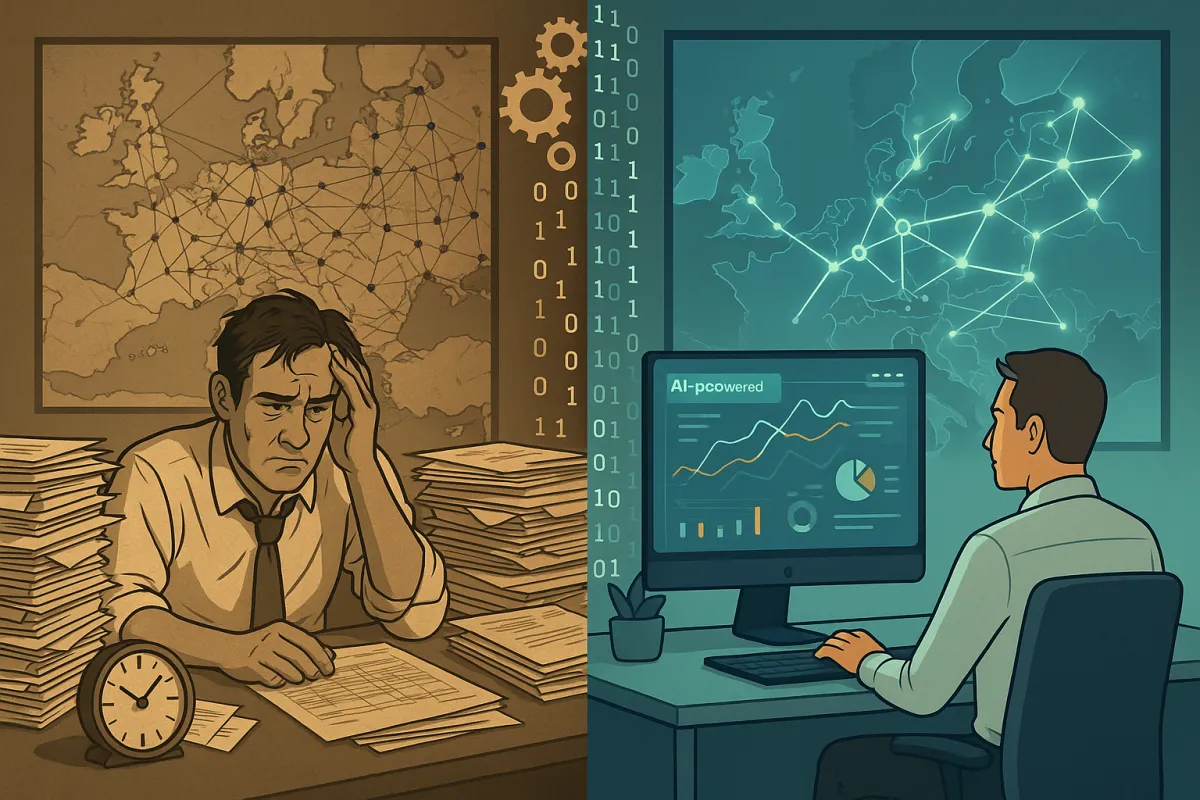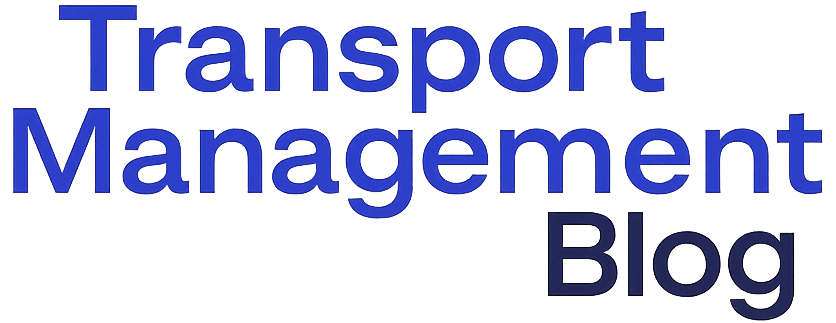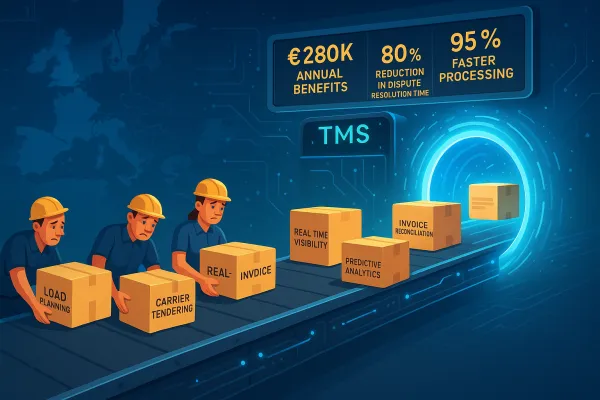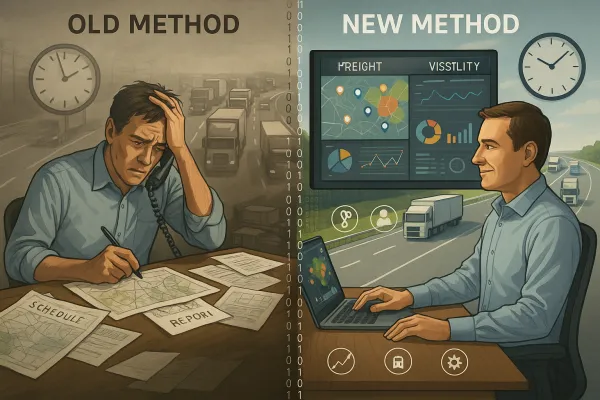The 83% Automation Gap: Why Most European Shippers Are Still Stuck in Manual Mode While AI-Powered Competitors Race Ahead

A mid-sized German automotive parts manufacturer had their procurement team spending 240 hours on each annual transport tender, managing responses from 25 carriers across 12 countries. Sound familiar? Only 17% of companies report being fully automated, while 96% are using generative AI somewhere in their transport operations.
This disconnect reveals what Descartes' 9th Annual Global Transportation Management Benchmark Survey calls the critical automation gap. While European shippers claim to embrace AI, most still rely on manual processes for core transport management functions. The cost? 8-12 weeks for manual tender cycles compared to 4-6 weeks with automation, plus countless hours lost to spreadsheet-driven rate comparisons and reactive exception management.
The Performance Divide: Financial Leaders vs. Laggards
The gap between automation leaders and laggards has never been wider. Companies with industry-leading financial performance show 51% full process automation, while those with below-average performance achieve only 5% automation. This isn't coincidence.
Gartner reports that TMS solutions with optimization features can deliver 2–15% ROI on transportation spend, with procurement capabilities rated at 2% to 10% ROI. For a European manufacturer with €50 million annual transport spend, automation can deliver €1-7.5 million in annual savings.
The numbers tell the story: 80% of respondents plan to increase their TMS spending, driven by companies seeing measurable returns. One practical rule many procurement teams follow: every euro invested in a capable TMS should return at least two euros in savings within 18 months.
Leading European companies report specific benefits beyond cost reduction. Early adopters of AI-driven procurement capabilities report 10-15% additional savings beyond basic automation benefits. When you can predict market trends, optimize tender timing, and automatically adjust to performance triggers, manual competitors simply can't keep pace.
Five Manual Bottlenecks Destroying European Shipper Efficiency
European transport operations face unique complexity that magnifies manual process inefficiencies. Here's where the biggest pain points surface:
Route planning remains spreadsheet-driven across most mid-sized shippers. While competitors use AI to optimize multi-modal routes considering traffic, weather, and delivery windows, manual planners spend hours cross-referencing carrier schedules. Most companies see ROI within 6–18 months from TMS deployment, yet they persist with methods that consume exponentially more resources.
Carrier rate comparisons eat up procurement teams' time. Manual tender processes require 240 hours for a single annual tender, while platforms handle routine re-tendering automatically based on performance triggers and market conditions. The European market's current shipper-favorable conditions make this an optimal time to leverage automated rate negotiations.
Freight audit and payment processes remain reactive rather than predictive. Gartner calculates automation capabilities could generate ROI of between 1% and 3% on freight cost savings alone. Yet most European shippers still manually verify invoices against contracts, missing overcharges and creating payment delays.
Exception management happens after problems occur instead of preventing them. Modern platforms flag delays before they escalate, but manual operations react to disruptions rather than anticipating them. When your team spends days managing what AI could prevent in minutes, competitive disadvantage compounds quickly.
Cross-border visibility gaps plague European operations specifically. Managing multi-currency rates, cross-border documentation, and varying carrier networks manually creates exponential complexity. With 426,000 unfilled truck driver positions across Europe and the transport management system market reaching €1.4 billion in 2024 at 12.2% annual growth, manual approaches simply can't scale.
The AI Acceleration Framework: 90-Day Implementation
The most successful European automation projects follow a phased approach that delivers measurable results within 90 days.
Days 1-30: Data Foundation and Quick Wins
Import historical shipment data and configure preferred carriers. Most users become comfortable with modern platforms within 48 hours. Focus on automating your highest-volume lanes first – typically 20% of routes represent 80% of spend. Set up automated rate comparisons and basic exception alerts. Document baseline metrics: current processing times, error rates, and cost per shipment.
Days 30-60: Core Workflow Automation
Deploy automated load tendering and carrier selection based on routing guides. Gartner estimates automation can yield 1–3% freight cost savings while eliminating countless hours of administrative work. Configure freight audit workflows and payment automation. Expand carrier network integrations beyond your core providers. Begin leveraging consolidation opportunities the system identifies automatically.
Days 60-90: AI-Powered Optimization
Activate predictive analytics for route optimization and capacity planning. Deploy automated exception management that addresses issues before they impact customers. Advanced analytics users see up to 8% reduction in transportation costs. Configure performance-based carrier evaluation and automated contract renegotiation triggers.
The key to European success: start with one major trade lane or carrier segment for pilot implementation. Document results carefully and use success metrics to justify broader deployment.
Technology Stack: European-Ready TMS Selection
Selecting the right platform requires understanding European operational requirements. Investment in transportation management systems is growing, with 80% planning to increase TMS spending, but not all solutions address European complexity effectively.
European shippers need platforms that handle multi-language operations, cross-border documentation, and diverse carrier integration requirements. Established enterprise vendors like Oracle TM, SAP TM, and MercuryGate offer comprehensive functionality but require significant implementation investment. Blue Yonder and Manhattan Active provide advanced AI capabilities suited for large-scale operations.
Mid-market European companies often benefit from specialized platforms. Cargoson focuses specifically on European manufacturers, wholesalers, and retailers, offering direct API/EDI integrations with carriers across all transport modes. Transporeon connects over 150,000 European carriers, while Alpega TMS serves 80,000+ transport professionals across Europe.
For North American platforms expanding to Europe, Shipwell and nShift offer modern cloud-based functionality, though European carrier integrations may be limited. The critical evaluation criteria: true API/EDI connections versus basic software accounts, European carrier network depth, and multi-modal transport support.
Total transport management system costs range from €100,000 to €500,000 for full-scale implementations, but cloud-based solutions offer subscription models starting around €50-500 per user monthly. Focus on total cost of ownership over five years, including integration and training costs.
Measuring Success: ROI Metrics That Matter
Successful automation requires tracking both leading and lagging indicators. Leading indicators show progress: percentage of loads automated, carrier response times, exception resolution speed. Lagging indicators prove value: cost per shipment, on-time delivery rates, customer satisfaction scores.
Build your business case around measurable 90-day wins. TMS solutions with optimization features often deliver ROI in the first few months of deployment. Target metrics include 30-50% reduction in tender processing time, 15-25% improvement in rate comparison accuracy, and 85% reduction in manual data entry.
Six-month targets should demonstrate broader operational impact: 10-20% freight cost reduction through better carrier selection and route optimization, 90% automated exception handling, and measurable improvement in customer service metrics. One-year success means full process automation delivering sustained 2:1 ROI on your platform investment.
Dashboard requirements for stakeholder buy-in: executive summary showing cost savings trends, operational metrics tracking automation adoption, and comparative analysis against manual process baselines. Finance teams need month-over-month savings data, operations teams need performance indicators, and management needs strategic insights about competitive positioning.
The 2025 Imperative: Why Waiting Costs More Than Acting
The automation gap will only widen in 2025. 75% of TMS vendors had AI innovations on their roadmaps for 2025, while manual processes become increasingly expensive to maintain. European capacity constraints make optimization critical – truck freight rates have increased by 25% as capacity gets booked further in advance.
Regulatory pressures compound the urgency. European emissions reporting requirements, cross-border documentation complexity, and sustainability mandates require sophisticated data management that manual processes can't deliver. Platforms are adding carbon calculation and reporting capabilities as standard features.
Market trends favor early adopters. Current favorable conditions for European shippers create optimal timing for negotiating better platform terms and carrier partnerships. Companies implementing automation now secure competitive advantages before market conditions shift.
The cost of inaction compounds daily. While you manage tenders manually, automated competitors capture market share through superior service and lower costs. The performance gap between automation leaders (51% fully automated) and laggards (5% fully automated) represents a strategic inflection point European shippers can't ignore.
Start your automation assessment immediately. Evaluate your current manual process costs, identify your highest-impact automation opportunities, and select implementation partners who understand European operational complexity. The 83% automation gap creates competitive opportunity, but only for companies willing to act decisively in 2025.





